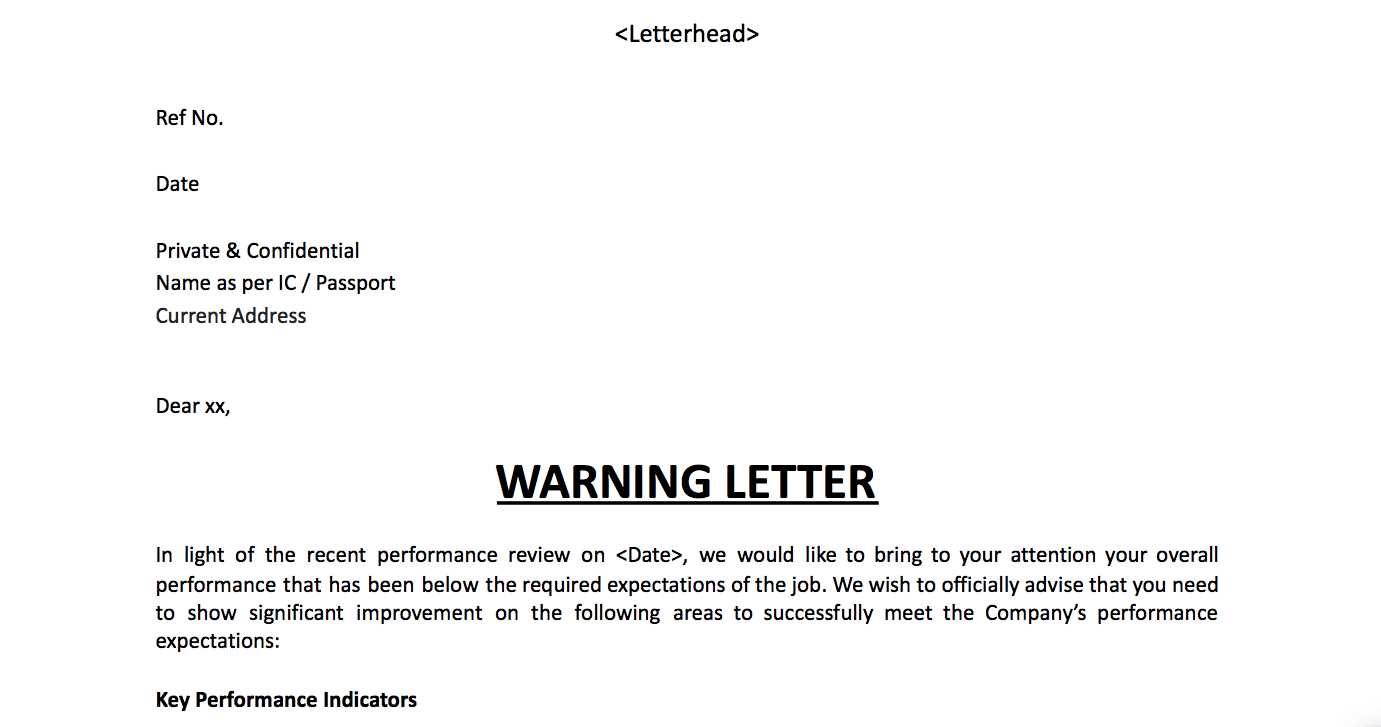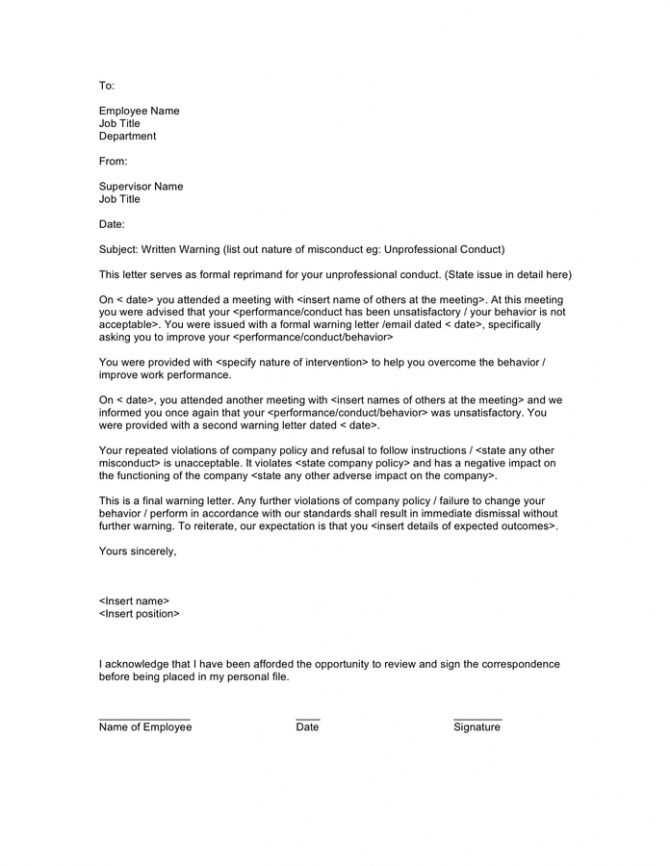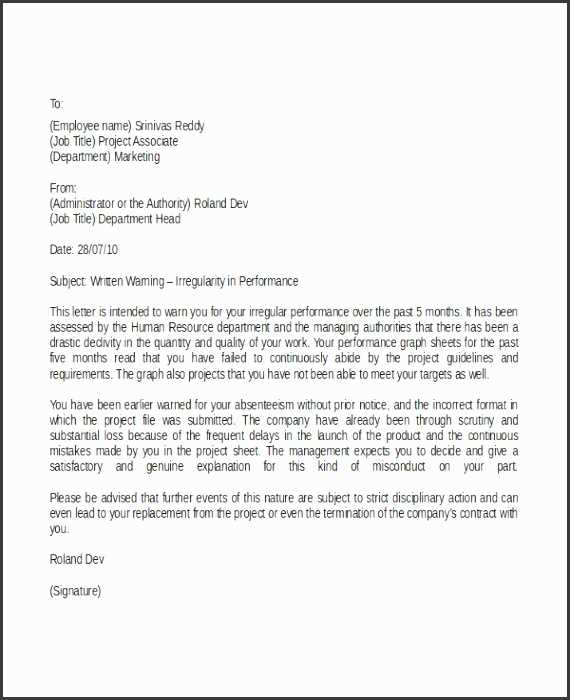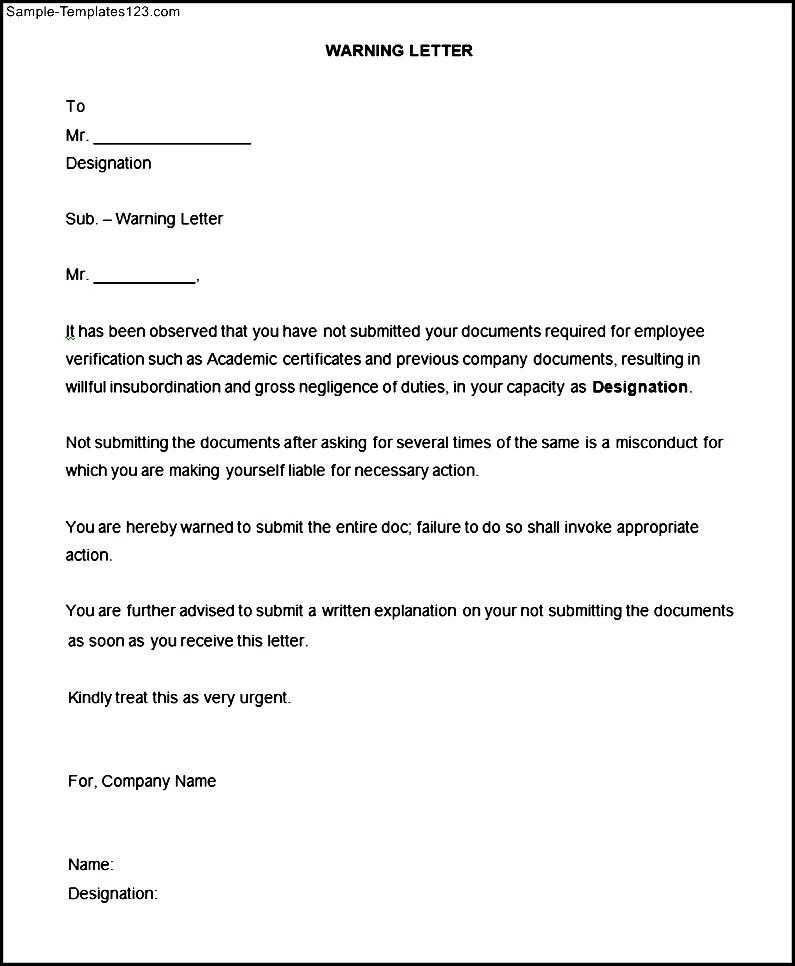Warning Letter Template for Addressing Misconduct

Addressing inappropriate conduct in the workplace is essential for maintaining a professional and productive environment. When an employee’s behavior falls below expected standards, it is crucial to address the issue in a clear and formal manner. This process ensures that both the employee and employer understand the severity of the situation and the necessary steps moving forward.
Creating a document that outlines the specific actions being addressed and the consequences can help prevent further issues. By drafting a structured response, employers can communicate their expectations while also providing the employee with an opportunity to improve. The document should be clear, direct, and professional, avoiding unnecessary language that may cause confusion or escalate the situation.
Proper documentation is key to ensuring that the action taken is legally sound and fair. An effective response not only corrects the behavior but also sets a precedent for handling similar situations in the future. This article provides guidance on how to craft such a document that aligns with company policies and legal standards.
How to Write a Warning Letter
When an employee’s actions require formal correction, it is important to communicate the issue clearly and professionally. A well-written document serves as an official notice of concern, outlining both the problem and the expected changes in behavior. The main goal is to inform the employee about the nature of the issue while providing a clear path for improvement.
Structuring the Document

Begin by clearly identifying the employee involved and describing the specific actions that have led to the formal notice. Avoid vague statements, and instead, focus on specific incidents that demonstrate the issue. Provide context and, where applicable, refer to previous discussions or warnings about the behavior in question. This helps ensure the employee understands the seriousness of the matter and that the issue has been ongoing.
Setting Expectations and Consequences

Next, outline what is expected of the employee moving forward. Be clear and precise about the desired changes in behavior and the steps the employee should take to meet company standards. It is also essential to explain the consequences of failing to make improvements, whether that involves further disciplinary action or other measures. This provides the employee with a clear understanding of the potential outcomes and encourages accountability.
Maintaining professionalism throughout this process is crucial. The tone of the communication should remain respectful and objective, with a focus on resolving the issue rather than assigning blame. The goal is to correct the behavior while maintaining a positive working relationship moving forward.
Essential Elements of a Misconduct Letter
When addressing inappropriate behavior in the workplace, certain elements are crucial to ensure the message is clear and effective. A well-constructed document not only outlines the issue at hand but also sets expectations for future conduct. Including the right details ensures that both the employee and employer are aligned on the necessary steps going forward.
First, the document should include a clear description of the actions that led to the formal communication. Specific examples help the employee understand exactly what behavior is being addressed and why it is problematic. This avoids ambiguity and ensures there is no confusion about the issue.
Additionally, it is essential to mention any previous conversations or warnings about the behavior. This provides context and shows that the matter has been addressed in the past, reinforcing the need for action. The document should also outline the expected improvements or changes in conduct, providing a roadmap for the employee to follow.
Finally, include the potential consequences of failing to improve. This could involve further disciplinary measures or a more formal review of the employee’s performance. By setting clear expectations and consequences, both parties can better understand the stakes and work towards resolution.
Common Mistakes to Avoid in Warning Letters
When addressing behavioral issues, it is easy to make mistakes that can undermine the effectiveness of the communication. These errors can lead to confusion, escalate the situation, or even cause legal complications. Avoiding common pitfalls is essential to ensure the message is clear, professional, and constructive.
One of the most frequent mistakes is failing to provide specific details about the behavior in question. Vague or generalized statements can leave the employee confused about what exactly needs to change. It is important to focus on concrete examples of the problematic actions to make the issue as clear as possible.
Another mistake is using an overly harsh or confrontational tone. While it is important to address the issue firmly, being overly critical can lead to resentment or defensiveness. The goal is to correct the behavior without damaging the relationship. A professional, respectful tone is key to achieving a positive outcome.
Additionally, neglecting to outline the steps for improvement and the consequences of failing to do so is a common error. Without clear expectations and consequences, the employee may not fully understand the seriousness of the matter or what is required to rectify the situation. Make sure to include these details to avoid any confusion.
Steps to Ensure Legal Compliance
When addressing inappropriate behavior in the workplace, it is crucial to follow proper procedures to avoid legal issues. Ensuring compliance with relevant labor laws and company policies helps protect both the employer and employee. Taking the right steps guarantees that any actions taken are fair, justified, and legally sound.
Understand Relevant Employment Laws

Before taking any formal action, it is essential to be familiar with the applicable local, state, and national laws regarding employee rights and disciplinary procedures. Different regions may have specific regulations that must be followed to avoid claims of discrimination, retaliation, or wrongful termination. Ensuring that you are aware of these laws helps you stay within legal boundaries.
Document All Steps and Communication
Proper documentation is one of the most important aspects of ensuring legal compliance. Keep a detailed record of all interactions with the employee, including any prior warnings or informal discussions. This helps establish a clear history of the issue and demonstrates that the employer took reasonable steps to address the behavior before taking formal action.
| Step | Action | Legal Consideration |
|---|---|---|
| Review Company Policies | Ensure the issue falls within company guidelines | Compliance with internal rules and regulations |
| Consult with HR or Legal Advisors | Seek guidance on how to proceed | Minimize risk of legal consequences |
| Provide Clear Documentation | Detail all incidents and communication | Protection against legal disputes |
By following these steps, employers can take appropriate action while minimizing the risk of legal complications. A well-documented, legally compliant approach helps ensure fairness and clarity for all parties involved.
Tips for Clear and Professional Communication
Effective communication is essential when addressing behavioral issues in the workplace. To ensure that the message is understood and constructive, it is important to use clear, direct language while maintaining a professional tone. Below are several tips to help achieve this goal.
- Be Specific – Avoid vague descriptions and provide concrete examples of the behavior in question. This helps the employee understand exactly what is being addressed and why it is a concern.
- Use Neutral Language – Ensure the tone remains respectful and neutral. Avoid language that may come across as accusatory or overly critical, as this can lead to defensiveness.
- Stay Objective – Focus on the facts of the situation rather than personal opinions or emotions. This ensures the conversation remains professional and centered on resolving the issue.
- Be Concise – Keep the message clear and to the point. Avoid unnecessary elaboration that may dilute the main message.
- Offer Solutions – Provide guidance on how the employee can improve and what steps are needed to meet expectations. This makes the communication more constructive.
Following these tips will help create a communication approach that is both effective and professional, ensuring the message is received in the intended manner and promoting a positive outcome for all involved.
Best Practices for Delivering the Letter
Delivering a formal communication about inappropriate behavior requires careful consideration of timing, setting, and approach. Ensuring that the process is handled with professionalism helps maintain respect and facilitates a constructive conversation. Below are some best practices for delivering the message effectively.
Choosing the Right Timing and Setting
- Schedule a Private Meeting – Always choose a private, quiet space where the employee feels comfortable discussing the issue without distractions or the presence of others.
- Choose the Right Moment – Ensure the timing is appropriate, avoiding high-stress periods or moments when the employee might already be dealing with other issues.
Maintain a Professional and Respectful Tone
- Be Calm and Composed – Deliver the message calmly and professionally, avoiding any emotional reactions that may escalate the situation.
- Focus on Resolution – Make sure to express that the goal is to improve the situation and help the employee succeed in the future, rather than merely pointing out flaws.
- Give Space for Dialogue – Allow the employee to ask questions or express their perspective. A two-way conversation can help clarify misunderstandings and promote a positive outcome.
By following these best practices, you can ensure the message is delivered effectively and with respect, fostering a constructive conversation that promotes improvement and understanding.